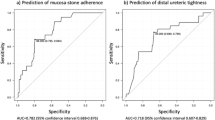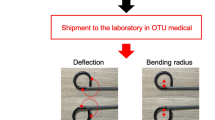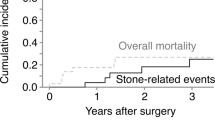Abstract
Ureteroscopy is the first-line treatment for urinary stone disease at many institutions. Techniques and indications continue to evolve. This Review covers the most current trends, controversies, and issues in ureteroscopic stone management. We present a summary of the most recent evidence regarding ureteroscopic treatment of ureteral and renal stones, current standard indications, adjunct devices and instruments used during ureteroscopy, and future directions.
Key Points
-
Ureteroscopy has become the first-line treatment for renal and ureteral stones in many centers
-
Ureteroscopic treatment of stone disease can be performed with high success rates and low complication rates
-
With increasing experience, indications for ureteroscopy have expanded to include large stones, bilateral stones, pediatric patients, pregnant patients, patients on anticoagulation medications and those with coagulopathy
-
Studies have demonstrated the advantages of a number of adjunct devices (for example, ureteral stents, ureteral access sheaths, and antiretropulsion devices) but their use during ureteroscopy is largely surgeon dependent
-
Improvements and innovations in the field of ureteroscopy are ongoing, with new devices such as digital ureteroscopes (currently in use) and robotic ureteroscopes (presently being developed) paving the way for further innovation
This is a preview of subscription content, access via your institution
Access options
Subscribe to this journal
Receive 12 print issues and online access
$209.00 per year
only $17.42 per issue
Buy this article
- Purchase on Springer Link
- Instant access to full article PDF
Prices may be subject to local taxes which are calculated during checkout
Similar content being viewed by others
References
Young, H. H. & McKay, R. W. Congenital valvular obstruction of the prostatic urethra. Surg. Gynecol. Obstet. 48, 509 (1929).
Marshall, V. F. Fiber optics in urology. J. Urol. 91, 110–114 (1964).
Goodman, T. M. Ureteroscopy with pediatric cystoscope in adults. Urology 9, 394 (1977).
Basillote, J. B., Lee, D. I., Eichel, L. & Clayman, R. V. Ureteroscopes: flexible, rigid, and semirigid. Urol. Clin. North Am. 31, 21–32 (2004).
Raney, A. M. Electrohydraulic ureterolithotripsy. Preliminary report. Urology 12, 284–285 (1978).
Das, S. Transurethral ureteroscopy and stone manipulation under direct vision. J. Urol. 125, 112–113 (1981).
Grocela, J. A. & Dretler, S. P. Intracorporeal lithotripsy. Instrumentation and development. Urol. Clin. North Am. 24, 13–23 (1997).
Dretler, S. P., Watson, G., Parrish, J. A. & Murray, S. Pulsed dye laser fragmentation of ureteral calculi: initial clinical experience. J. Urol. 137, 386–389 (1987).
Dretler, S. P. & Cho, G. Semirigid ureteroscopy: a new genre. J. Urol. 141, 1314–1316 (1989).
Ritchey, M., Patterson, D. E., Kelalis, P. P. & Segura, J. W. A case of pediatric ureteroscopic lasertripsy. J. Urol. 139, 1272–1274 (1988).
Conlin, M. J., Marberger, M. & Bagley, D. H. Ureteroscopy. Development and instrumentation. Urol. Clin. North Am. 24, 25–42 (1997).
Preminger, G. M. et al. 2007 guideline for the management of ureteral calculi. J. Urol. 178, 2418–2434 (2007).
Nabi, G., Downey, P., Keeley, F., Watson, G. & McClinton, S. Extra-corporeal shock wave lithotripsy (ESWL) versus ureteroscopic management for ureteric calculi. Cochrane Database of Systematic Reviews, Issue 1. Art. No.: CD006029. doi:10.1002/14651858.CD006029.pub2 (2007).
Elashry, O. M. et al. Ureteroscopic management of lower ureteric calculi: a 15-year single-centre experience. BJU Int. 102, 1010–1017 (2008).
Chow, G. K. et al. Ureteroscopy: effect of technology and technique on clinical practice. J. Urol. 170, 99–102 (2003).
Krambeck, A. E. et al. The evolution of ureteroscopy: a modern single-institution series. Mayo Clin. Proc. 81, 468–473 (2006).
Pearle, M. S. et al. Prospective randomized trial comparing shock wave lithotripsy and ureteroscopy for lower pole caliceal calculi 1 cm or less. J. Urol. 179 (Suppl.), S69–S73 (2008).
Kourambas, J., Delvecchio, F. C., Munver, R. & Preminger, G. M. Nitinol stone retrieval-assisted ureteroscopic management of lower pole renal calculi. Urology 56, 935–939 (2000).
Elbahnasy, A. M. et al. Lower-pole caliceal stone clearance after shockwave lithotripsy, percutaneous nephrolithotomy, and flexible ureteroscopy: impact of radiographic spatial anatomy. J. Endourol. 12, 113–119 (1998).
Ackermann, D. K., Fuhrimann, R., Pfluger, D., Studer, U. E. & Zingg, E. J. Prognosis after extracorporeal shock wave lithotripsy of radiopaque renal calculi: a multivariate analysis. Eur. Urol. 25, 105–109 (1994).
Perks, A. E. et al. Stone attenuation and skin-to-stone distance on computed tomography predicts for stone fragmentation by shock wave lithotripsy. Urology 72, 765–769 (2008).
Irwin, B. H. & Desai, M. Ureteroscopic superiority to extracorporeal shock wave lithotripsy for the treatment of small-to-medium-sized intrarenal non-staghorn calculi. Urology 74, 256–258 (2009).
Kourambas, J., Delvecchio, F. C., Munver, R. & Preminger, G. M. Nitinol stone retrieval-assisted ureteroscopic management of lower pole renal calculi. Urology 56, 935–939 (2000).
Kourambas, J., Delvecchio, F. C. & Preminger, G. M. Low-power holmium laser for the management of urinary tract calculi, structures, and tumors. J. Endourol. 15, 529–532 (2001).
Schuster, T. G., Hollenbeck, B. K., Faerber, G. J. & Wolf, J. S. Jr. Ureteroscopic treatment of lower pole calculi: comparison of lithotripsy in situ and after displacement. J. Urol. 168, 43–45 (2002).
Grasso, M., Conlin, M. & Bagley, D. Retrograde ureteropyeloscopic treatment of 2 cm or greater upper urinary tract and minor Staghorn calculi. J. Urol. 160, 346–351 (1998).
Ricchiuti, D. J. et al. Staged retrograde endoscopic lithotripsy as alternative to PCNL in select patients with large renal calculi. J. Endourol. 21, 1421–1424 (2007).
Riley, J. M., Stearman, L. & Troxel, S. Retrograde ureteroscopy for renal stones larger than 2.5 cm. J. Endourol. 23, 1395–1398 (2009).
El-Anany, F. G., Hammouda, H. M., Maghraby, H. A. & Elakkad, M. A. Retrograde ureteropyeloscopic holmium laser lithotripsy for large renal calculi. BJU Int. 88, 850–853 (2001).
Mugiya, S., Suzuki, K., Ushiyama, T. & Fujita, K. Combined treatment of staghorn calculi by fiberoptic transurethral nephrolithotripsy and extracorporeal shock wave lithotripsy. Int. J. Urol. 5, 129–133 (1998).
Smaldone, M. C. et al. Is ureteroscopy first line treatment for pediatric stone disease? J. Urol. 178, 2128–2131 (2007).
Tan, A. H., Al-Omar, M., Denstedt, J. D. & Razvi, H. Ureteroscopy for pediatric urolithiasis: an evolving first-line therapy. Urology 65, 153–156 (2005).
Basiri, A., Zare, S., Shakhssalim, N. & Hosseini Moghaddam, S. M. Ureteral calculi in children: what is best as a minimally invasive modality? Urol. J. 5, 67–73 (2008).
Ulvik, N. M., Bakke, A. & Høisaeter, P. A. Ureteroscopy in pregnancy. J. Urol. 154, 1660–1663 (1995).
Semins, M. J., Trock, B. J. & Matlaga, B. R. The safety of ureteroscopy during pregnancy: a systematic review and meta-analysis. J. Urol. 181, 139–143 (2009).
Swartz, M. A., Lydon-Rochelle, M. T., Simon, D., Wright, J. L. & Porter, M. P. Admission for nephrolithiasis in pregnancy and risk of adverse birth outcomes. Obstet. Gynecol. 109, 1099–1104 (2007).
Kavoussi, L. R., Albala, D. M., Basler, J. W., Apte, S. & Clayman, R. V. Percutaneous management of urolithiasis during pregnancy. J. Urol. 148, 1069–1071 (1992).
Khoo, L., Anson, K. & Patel, U. Success and short-term complication rates of percutaneous nephrostomy during pregnancy. J. Vasc. Interv. Radiol. 15, 1469–1473 (2004).
McAleer, S. J. & Loughlin, K. R. Nephrolithiasis and pregnancy. Curr. Opin. Urol. 14, 123–127 (2004).
Turna, B. et al. Safety and efficacy of flexible ureterorenoscopy and holmium:YAG lithotripsy for intrarenal stones in anticoagulated cases. J. Urol. 179, 1415–1419 (2008).
Watterson, J. D. et al. Safety and efficacy of holmium: YAG laser lithotripsy in patients with bleeding diatheses. J. Urol. 168, 442–445 (2002).
Klingler, H. C. et al. Stone treatment and coagulopathy. Eur. Urol. 43, 75–79 (2003).
Pearle, M. S. et al. Prospective randomized trial comparing shock wave lithotripsy and ureteroscopy for lower pole caliceal calculi 1 cm or less. J. Urol. 173, 2005–2009 (2005).
Hollenbeck, B. K., Schuster, T. G., Faerber, G. J. & Wolf, J. S. Jr. Safety and efficacy of same-session bilateral ureteroscopy. J. Endourol. 17, 881–885 (2003).
Grossi, F. S. et al. Bilateral same session ureteroscopy: safety and efficacy. Arch. Ital. Urol. Androl. 79, 20–22 (2007).
Gunlusoy, B. et al. Bilateral single-session ureteroscopy with pneumatic lithotripsy for bilateral ureter stones: feasible and safe. Urol. Int. 81, 202–205 (2008).
Ryan, P. C., Lennon, G. M., McLean, P. A. & Fitzpatrick, J. M. The effects of acute and chronic JJ stent placement on upper urinary tract motility and calculus transit. Br. J. Urol. 74, 434–439 (1994).
Knudsen, B. E., Beiko, D. T. & Denstedt, J. D. Stenting after ureteroscopy: pros and cons. Urol. Clin. North Am. 31, 173–180 (2004).
Chen, Y. T. et al. Is ureteral stenting necessary after uncomplicated ureteroscopic lithotripsy? A prospective, randomized controlled trial. J. Urol. 167, 1977–1980 (2002).
Rapoport, D., Perks, A. E. & Teichman, J. M. Ureteral access sheath use and stenting in ureteroscopy: effect on unplanned emergency room visits and cost. J. Endourol. 21, 993–997 (2007).
Vanlangendonck, R. & Landman, J. Ureteral access strategies: pro-access sheath. Urol. Clin. North Am. 31, 71–81 (2004).
Kourambas, J., Byrne, R. R. & Preminger, G. M. Does a ureteral access sheath facilitate ureteroscopy? J. Urol. 165, 789–793 (2001).
Abrahams, H. M. & Stoller, M. L. The argument against the routine use of ureteral access sheaths. Urol. Clin. North Am. 31, 83–87 (2004).
Lallas, C. D. et al. Laser Doppler flowmetric determination of ureteral blood flow after ureteral access sheath placement. J. Endourol. 16, 583–590 (2002).
Delvecchio, F. C. et al. Assessment of stricture formation with the ureteral access sheath. Urology 61, 518–522 (2003).
Geavlete, P., Georgescu, D., Nita, G., Mirciulescu, V. & Cauni, V. Complications of 2735 retrograde semirigid ureteroscopy procedures: a single-center experience. J. Endourol. 20, 179–185 (2006).
Marguet, C. G. et al. In vitro comparison of stone retropulsion and fragmentation of the frequency doubled, double pulse nd:yag laser and the holmium:yag laser. J. Urol. 173, 1797–1800 (2005).
Gonen, M., Cenker, A., Istanbulluoglu, O. & Ozkardes, H. Efficacy of dretler stone cone in the treatment of ureteral stones with pneumatic lithotripsy. Urol. Int. 76, 159–162 (2006).
Eisner, B. H., Pengune, W. & Stoller, M. L. Use of an antiretropulsion device to prevent stone retropulsion significantly increases the efficiency of pneumatic lithotripsy: an in vitro study. BJU Int. 104, 858–861 (2009).
Desai, M. R. et al. The Dretler stone cone: a device to prevent ureteral stone migration—the initial clinical experience. J. Urol. 167, 1985–1988 (2002).
Lee, H. J. et al. In vitro evaluation of nitinol urological retrieval coil and ureteral occlusion device: retropulsion and holmium laser fragmentation efficiency. J. Urol. 180, 969–973 (2008).
Eisner, B. H. & Dretler, S. P. Use of the Stone Cone for prevention of calculus retropulsion during holmium:YAG laser lithotripsy: case series and review of the literature. Urol. Int. 82, 356–360 (2009).
Sacco, D., McDougal, W. S. & Schwarz, A. Preventing migration of stones during fragmentation with thermosensitive polymer. J. Endourol. 21, 504–507 (2007).
Adiyat, K. T., Meuleners, R. & Monga, M. Selective postoperative imaging after ureteroscopy. Urology 73, 490–493 (2009).
Leijte, J. A., Oddens, J. R. & Lock, T. M. Holmium laser lithotripsy for ureteral calculi: predictive factors for complications and success. J. Endourol. 22, 257–260 (2008).
Humphreys, M. R. et al. A new world revealed: early experience with digital ureteroscopy. J. Urol. 179, 970–975 (2008).
Desai, M. M. et al. Flexible robotic retrograde renoscopy: description of novel robotic device and preliminary laboratory experience. Urology 72, 42–46 (2008).
Canes, D., Lehman, A. C., Farritor, S. M., Oleynikov, D. & Desai, M. M. The future of NOTES instrumentation: Flexible robotics and in vivo minirobots. J. Endourol. 23, 787–792 (2009).
Author information
Authors and Affiliations
Corresponding author
Ethics declarations
Competing interests
B. H. Eisner has been a consultant for The Ravine Group, PercSys, and has received speakers bureau honoraria from Boston Scientific. S. P. Dretler has been a consultant for Accellent and Oxford Bioscience. M. P. Kurtz declares no competing interests.
Rights and permissions
About this article
Cite this article
Eisner, B., Kurtz, M. & Dretler, S. Ureteroscopy for the management of stone disease. Nat Rev Urol 7, 40–45 (2010). https://doi.org/10.1038/nrurol.2009.233
Published:
Issue Date:
DOI: https://doi.org/10.1038/nrurol.2009.233



